Manufacturing
-
- A Step Forward For Thick Section Plate Cutting Maritime Reporter, Jun 2003 #77
For years, general manufacturing companies have enjoyed the benefit of laser cutting systems for producing complex or simple parts in batch volumes as low as one, and as high as tens of thousands.
The laser is an incredibly powerful tool that remains unsurpassed in manufacturing activities across the world. As flexible and reconfigurable production tool that provides welding, cutting and machining capabilities in a single device, lasers are readily automated and have demonstrated that they can easily operate in "lights-out" mode for even greater productivity. With all this said, why aren't there any laser shipyards?
Why hasn't one of the worlds largest and most important transportation industries rushed to implement laser cutting and welding technology? The answer is that the development of the state-of-the-art laser manufacturing technology has been a long and grueling process. Early lasers were just not powerful or reliable enough to attract an industry that had the capability to process heavy section metals using low cost and reliable technologies such as oxy-fuel and plasma cutting, with MIG and TIG and submerged arc techniques being the process of choice for welding. Even the Lloyds approval for laser welding of ship plates has yet to see lasers become commonplace in shipyards. The situation today is rather different. Lasers are now being employed commercially in thick plate cutting and welding and the industry has witnessed a quiet and rather successful processing revolution.
A new, and unexpected, breakthrough in the laser industry occurred in November 2002 at Bender Shipbuilding & Repair in Mobile, Ala. It was there that the first commercial use of the LASOX process cut through two in. of steel using a new cutting principle industrialized by Wayne Penn and his team from Alabama Laser. Co-developed by BOC Gases Ltd. and Dr. Bill O'Neill while working at the University of Liverpool, the LASOX process requires approximately 1 kW of laser power and uses oxygen to provide the cutting energy while the laser is used to maintain and stabilize a pre-heat - similar to the gas flame in oxy-fuel cutting.
With O'Neill and his team working on the thick section problem for more than a decade, commercial laser cutting has pushed the section limit from around 15 mm in 1990, to around 30 mm in 2003, with a subsequent increase in laser power from 2kW to 6kW. The process remains the same except the size of the process window is inversely proportional to the plate thickness. Prior to the invention of LASOX, it was a daunting process to cut pieces of high thickness.
As a result, there is always the temptation of turning up the power and the gas and just "letting it rip. While the LASOX process, however, will reportedly have the ability to produce the fastest scrap metal production system in the world, it will not, however, solve the problem of producing laser cuts up from 50-75 mm. "A year ago, cutting steel thicker than two inches would have been unheard of with a 2kW laser - one in.
being the maximum cutting depth undertaken commercially." said Pat Cahill, research and development manager for Bender Shipbuilding. "This process has the potential to cut steel plates as thick as four in. Currently highpowered plasma cutting is limited to three in. This development opens up the possibility of a new generation of steel ships that are stronger and cheaper to build." v With BOC Gases and the University of Liverpool providing the basic technology and process license for LASOX, Alabama Laser Systems carried out pre-production development of the lab based process and the integration into the existing laser cutting system at Bender Shipbuilding. The installation has been so successful that full installations at Caterpillar, for their heavy duty mining equipment; and General Dynamics - Electric Boat, for use in the building of submarines will be completed three months ahead of schedule.
In The Beginning LASOX cutting is the result of 13 years research by Dr. Jack Gabzdyl.
BOC's market development manager at the U.K.-based Fabrication Technology Center in Wolverhampton and Dr. Bill O'Neill formerly of the University of Liverpool, and now working at the Institute of Manufacturing at the University of Cambridge, UK. BOC Gases awarded O'Neill a Royal Society Industrial Research Fellowship to conduct a four-year study on laser cutting in 1990 - the outcome of his work being the LASOX process. O'Neill had been working on the thick section cutting problem by examining the dynamic effects of melt and gas flow through deep section kerfs and became convinced that the problem could be solved by forgetting the conventional laser cutting approach. "In 1990 the Holy Grail at that time was the ability to cut thick plate steel. In the early 1990s, laser cutting was very much limited to about 12 o 15 mm (0.48 to 0.6 in.). That's when we started looking at ways in which we could assist the thickness capability of laser cutting materials. We were quite convinced that the gas played a significant role," said Gabzdyl. So we turned the basic principles of laser cutting on its head, and looked to our expertise in oxy-fuel cutting where we realised hat the oxygen is really the process workhorse," he said.
He continued: "In traditional laser beam cutting, the laser is the workhorse while the oxygen assists in the process.
The oxygen just helps. We inverted that philosophy in laser cutting and made the oxygen jet the workhorse and the laser beam the assist." The LASOX cutting process is an exothermic burning reaction in which the heat of the laser beam is only used to bring the steel to ignition temperature at approximately 1,832°F (1,000° C). A specially designed nozzle is used to deliver a supersonic stream of oxygen to the heated spot, resulting in ignition and then sustained burning. LASOX combines the benefits of lasers and oxyfuel cutting by using a very modest amount of laser energy by conventional standards, about lkW, so the process can be operated with relatively small low cost lasers. This laser beam in effect replaces the fuel gas in oxy-fuel cutting. The laser beam is then combined with a high pressure supersonic oxygen gas jet, which provides the cutting energy.
Thicker material has traditionally been cut with oxyfuel and more recently with plasma torches but both processes suffer from quality issues. "When we started in the early 1990s, we would have been happy to cut one-in. steel plate. But as it happens, we've been able to cut increasingly thicker plate. By careful manipulation of the nozzle geometry and the beam chara c t e r i s t i c s , we can cut very thick material - up to about four in.
plate," said Gabzdyl.
Another advantage of LASOX is that it is instantaneous.
"There is no preheating element required to start the piercing process. In cutting two-in. steel with oxy-fuel, you ^ would need to put the flame on the surface for about 30 seconds before hitting the cutting oxygen jet to make the pierce. Whereas with the LASOX process, because the laser heats the surface instantaneously to the ignition temperature, as soon as you turn the laser on, you can turn on the gas stream and start piercing," explained Gabzdyl.
In January 2001, Gabzdyl and O'Neill were invited to present their findings on LASOX at a meeting at Caterpillar in Peoria, 111. "We turned everything on its head. We explained that the laser is not the important thing, it's actually the gas that does the trick. This astonished the laser community there, because they tend to be very laser-centric people who feel that the laser is always the most important thing," recalled Gabzdyl. "It definitely caught my eye," said Cahill, referring to the presentation. Later that evening, Gabzdyl, O'Neill, Cahill of Bender Shipbuilding and Penn of Alabama Lasers had discussions with the view to establishing this process in the shipbuilding industry.
In February 2001, Cahill pulled together the team of Bender Shipbuilding, Alabama Laser and BOC Gases, and wrote a proposal to the National Shipbuilding Research Program, (NSRP). "The proposal got selected and we moved forward. Less than a year after we started real work on it, we were using LASOX in production.
We went from the laboratory to production at almost lightning speed," said Cahill.
Penn, who serves as president of Alabama Laser agreed. "What we brought to the equation was taking LASOX out of the lab and making it work on the industrial floor. There's a big difference in doing something once in a lab and doing it a thousand times on the industrial floor," he said. "I've been working with lasers for 30 years and every now and then I see a quantum leap and LASOX fits into that category." Penn continued: "An important aspect of LASOX that isn't often mentioned is its ability to do intricate detail even on thick plate. We've been able to cut webs that just can't be achieved with other methods. The LASOX process supplies just enough heat to drive the reaction and a lot of that heat energy is removed through the kerf. Plasma cannot do the square cuts that allows you to do common line cutting with feature detail and a minimum heat for the part with a minimum amount of distortion, those features alone solve certain categories of problems. This is a tool to give you more capability, not a tool to displace other technologies. It gives someone that is going to invest a million dollars in a laser system with a new tool. It allows him to cut thicker plate without having to go out and buy a plasma or oxyfuel system and making a lot of redundancy and using up a lot more floor space." According to Pat Cahill of Bender, "LASOX is going to completely change the way people look at lasers as a cutting tool," said Cahill. "We're saving hours and hours of machine shop time because we're able to cut holes that are of machine quality. In the past we would cut the blanks out with an oxy-burner and take them to the machine shop and drill them." "LASOX has an almost zero kerf angle, an inch and a half material with less than one degree of a kerf angle. So you have a straight edge. It has almost no top edge melting at all." Turn to page 89 for updates on the latest Welding and Cutting Technologies
-
- R.A. Baker To Head New Hillman Company Maritime Reporter, Feb 15, 1977 #26
Robert A. Baker Jr. has been elected president of Hillman Manufacturing Company, which has been formed to consolidate and focus on certain of the engineering and manufacturing companies owned by The Hillman Company. The new group has approximately 1,600 employees and is expected to produce sales
-
- Report Shows 101 Plants Locate Waterside In First Quarter Of 1977 Maritime Reporter, Oct 1977 #51
plants, four were terminals, docks and wharves, three were paper and wood-producing plants, and the remainder consisted of general manufacturing and miscellaneous installations. The Mississippi River led with 22 facilities, followed by the Houston Ship Channel with 13, the Gulf Intracoastal
-
- Marathon Manufacturing Adds $61 Million To Drilling Rig Backlog Maritime Reporter, Sep 15, 1977 #9
Marathon Manufacturing Company, Houston, Texas, has announced that with firm construction contracts negotiated in August f o r four of its offshore jackup drilling rigs, a total of $61 million has been added to its marine construction backlog. The contracts for Marathon jackup rigs are with the
-
- Marland Expanding— Manufacturing Facility Moved To Wisconsin Maritime Reporter, Jun 1977 #24
Marland Environmental Systems, Inc., one o f the leading manufacturers of marine sewage systems, is moving its entire manufacturing facility to Walworth, Wis., the location of its parent company, LaMere Industries, Inc. In announcing the location change, Robert L. Ward, chairman of the board for
-
- Diamond Manufacturing Building Ro/Ro Dock For Port Of Tampa Maritime Reporter, Nov 15, 1977 #38
, will fill an important need at the port, according to port director Guy N. Verger. C o n s t r u c t i o n contract was awarded to Diamond Manufacturing Co. of Savannah, Ga., the low bidder. The 15,400-square-foot platform will be of concrete construction supported by concrete piles, and will
-
- Vicinay Chain Company Officially Opens New Corpus Christi Manufacturing Plant Maritime Reporter, Jun 15, 1976 #12
Vicinay Chain Company, Inc., recently opened the firm's new manufacturing plant in Corpus Christi, Texas, with an official inauguration. Larry Moncus, president of Vicinay Chain Company and Vicinay International Company, presided during the ceremonies and introduced the members of the firm, including
-
- Tampa Yacht Manufacturing’s TEMPEST 50-FAC Marine News, Apr 2013 #10
The Tempest 50-FAC from Tampa Yacht Manufacturing (TYM) is designed to provide Patrol and surveillance in shallow coastal and riverine waters by day and night in marshy areas of creeks with shifting sand bars, with low draft, high maneuverability and speed. The vessel’s hull design, which includes forward
-
- Tampa Yacht Manufacturing Introduces New Twists to Old Concepts Marine News, Oct 2013 #46
In-House Design Changes are no problem at Tampa Yacht Manufacturing. Whether of internal design and manufacture or tweaking of standard, commercially available off-the-shelf marine equipment, TYM went the extra yard for its customers. Tempest 36RHIB – Wing Hybrid Collar system with field interchangeability
-
- Abex-Denison Div. Appoints Feierabend VP-Manufacturing Maritime Reporter, Mar 1977 #18
Erich H. Feierabend has been named vice president of manufacturing for Abex Corporation, Denison Division, according to an announcement by B.R. Horne, division president. Mr. Feierabend will be located at the division's headquarters in Columbus, Ohio, and will be responsible for all United States
-
- Marinette Marine Corp. Appoints J.R. Derusha Manufacturing VP Maritime Reporter, Apr 1977 #10
James R. Derusha has been appointed vice president of manufacturing at Marinette Marine Corporation, Ely Street, Marinette, Wis. 54143. It is the latest of several management positions Mr. Derusha has held during his 20 years with the Wisconsin shipbuilder. Most recently, he served as vice president
-
- Manufacturing Better Bearings for the Marine Industry Maritime Reporter, Jan 2003 #36
In the last few decades, the maritime industry has faced increasing pressures to perform with less and still earn a profit. Fuel costs have skyrocketed. Labor costs have risen dramatically. Down time for repairs has cut into profit margins. Marine engineers and maritime operators have been looking
-
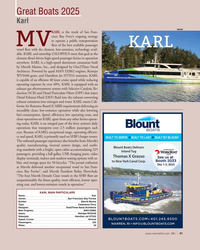 )
November 2025 - Marine News page: 41
)
November 2025 - Marine News page: 41ef? cien- cy and speed, KARL is primarily used on SFBF’s longer routes. The onboard passenger experience also bene? ts from Mavrik’s quality manufacturing, internal system design, and out? t- ting standards with a bright, open cabin accommodating 325 passengers, providing a full galley, USB charging
-
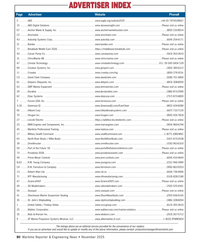 )
November 2025 - Maritime Reporter and Engineering News page: 80
)
November 2025 - Maritime Reporter and Engineering News page: 80. . . . . . . . . . . . . .www.ral.ca . . . . . . . . . . . . . . . . . . . . . . . . . . . . . . . . . . . . . . . . . .(604) 736-9466 71 . . . . .RTF Manufacturing . . . . . . . . . . . . . . . . . . . . . . . . . . . . . . . . . .www.rtfmanufacturing.com . . . . . . . . . . . . . . . . . . . . . . . . .
-
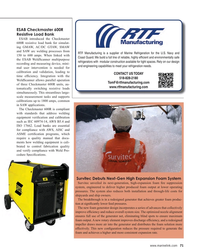 )
November 2025 - Maritime Reporter and Engineering News page: 71
)
November 2025 - Maritime Reporter and Engineering News page: 71Load Bank ESAB introduced the Checkmaster 600R resistive load bank for simulat- ing GMAW, AC/DC GTAW, SMAW and SAW arc welding processes from RTF Manufacturing is a supplier of Marine Refrigeration for the U.S. Navy and 150 to 600 amps. When linked with Coast Guard. We build a full line of reliable,
-
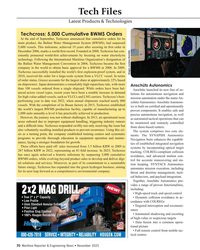 )
November 2025 - Maritime Reporter and Engineering News page: 70
)
November 2025 - Maritime Reporter and Engineering News page: 70Busan factory in 2015, Techcross established ics is built on certi? ed and operationally the world’s largest BWMS production facility, capable of manufacturing up to proven components. It enables safe and 1,000 units annually-a level it has practically achieved in production. precise autonomous navigation
-
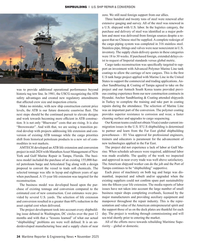 )
November 2025 - Maritime Reporter and Engineering News page: 34
)
November 2025 - Maritime Reporter and Engineering News page: 34the market. “shipbuilding” problems are were well de? ned. It is an un- All of the efforts move towards rebuilding Maritime Supe- derdeveloped manufacturing base and a supply chain of near riority – global or domestic. 34 Maritime Reporter & Engineering News • November 2025 MR #11 (34-49).indd 34
-
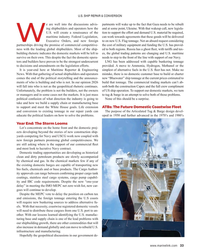 )
November 2025 - Maritime Reporter and Engineering News page: 33
)
November 2025 - Maritime Reporter and Engineering News page: 33problems. political confusion of what direction the industry is going to None of this should be a surprise. take and how we build a supply chain or manufacturing base ATBs: The Future Domestic Coastwise Fleet to support and meet the White House goals. Life extension and conversion to existing tonnage in
-
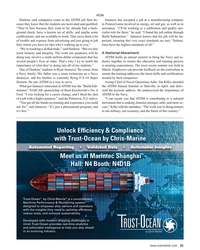 )
November 2025 - Maritime Reporter and Engineering News page: 31
)
November 2025 - Maritime Reporter and Engineering News page: 31ATDM Hankins said companies come to the ATDM job fairs be- Jannuzzi has accepted a job at a manufacturing company cause they know that the students are motivated and quali? ed. in Pennsylvania involved in energy, oil and gas, as well as in “They’re here because they want to be; already had a back-
-
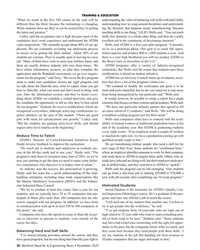 )
November 2025 - Maritime Reporter and Engineering News page: 30
)
November 2025 - Maritime Reporter and Engineering News page: 30how to wrap around disciplines and understand- When students show up, they’re can be assured they’re getting ing the dynamic that happens inside manufacturing. Because the latest and greatest.” teaching skills is one thing,” IALR’s Wells said. “You can teach Culley said the acceptance rate is high
-
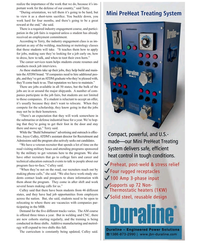 )
November 2025 - Maritime Reporter and Engineering News page: 29
)
November 2025 - Maritime Reporter and Engineering News page: 29three times a year. But in welding and CNC, there are new cohorts starting regularly, and the training is being conducted in three shifts. Additive manufacturing and metrol- ogy will expand to two shifts this fall. The curriculum is constantly being updated, Culley said. MR #11 (18-33).indd 29 MR #11
-
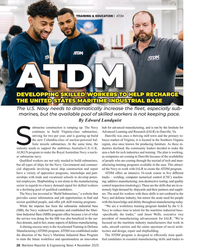 )
November 2025 - Maritime Reporter and Engineering News page: 26
)
November 2025 - Maritime Reporter and Engineering News page: 26, but the available pool of skilled workers is not keeping pace. By Edward Lundquist ubmarine construction is ramping up. The Navy hub for advanced manufacturing, and is run by the Institute for continues to build Virginia-class submarines, Advanced Learning and Research (IALR) in Danville, Va. striving
-
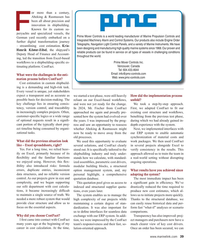 )
October 2025 - Maritime Reporter and Engineering News page: 39
)
October 2025 - Maritime Reporter and Engineering News page: 39Telegraphs, Navigation Light Control Panels, and a variety of Marine Instruments. We have – streamlining cost estimation. Kris- been designing and manufacturing high quality marine systems since 1968. Our proven and Henrik Köster-Eibel, the shipyard’s reliable products can be found in service on all types
-
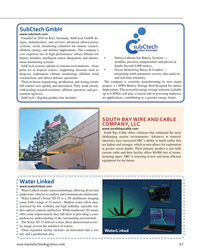 )
September 2025 - Marine Technology Reporter page: 67
)
September 2025 - Marine Technology Reporter page: 67, and subsea defense operations. and real-time telemetry. Their in-house engineering, production, and testing ensure The company is currently manufacturing its next major full control over quality and innovation. They work closely project: a 1 MWh Battery Storage Skid designed for subsea with leading
-
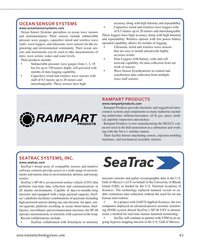 )
September 2025 - Marine Technology Reporter page: 63
)
September 2025 - Marine Technology Reporter page: 63to many industries includ- ing underwater, military/aerospace, oil & gas, space, medi- cal, pipeline inspection and nuclear. Rampart Products is now manufacturing the M24231 con- nector used in the hull penetration in a submarine and work- ing with the Navy’s warfare centers. Their facility houses machining
-
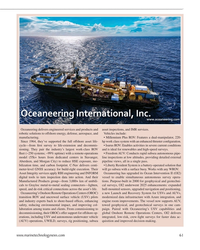 )
September 2025 - Marine Technology Reporter page: 61
)
September 2025 - Marine Technology Reporter page: 61services and products and asset inspections, and IMR services. robotic solutions to offshore energy, defense, aerospace, and Vehicles include: manufacturing. • Millennium Plus ROV: Features a dual-manipulator, 220- Since 1964, they’ve supported the full offshore asset life- hp work class system with
-
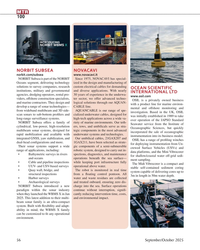 )
September 2025 - Marine Technology Reporter page: 56
)
September 2025 - Marine Technology Reporter page: 56www.novacavi.it NORBIT Subsea is part of the NORBIT Since 1975, NOVACAVI has special- Oceans segment, delivering technology ized in the design and manufacturing of solutions to survey companies, research custom electrical cables for demanding OCEAN SCIENTIFIC institutions, military and governmental
-
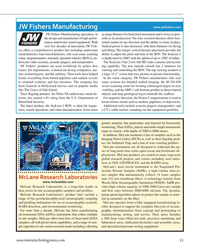 )
September 2025 - Marine Technology Reporter page: 53
)
September 2025 - Marine Technology Reporter page: 53www.jw? shers.com JW Fishers Manufacturing JW Fishers Manufacturing specializes in as many thrusters for horizontal movement and is twice as pow- the design and manufacture of high-perfor- erful as its predecessor. The four vectored thrusters allow hori- mance underwater search equipment. With zontal
-
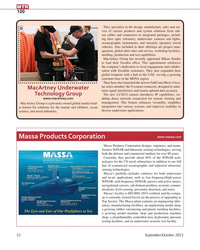 )
September 2025 - Marine Technology Reporter page: 52
)
September 2025 - Marine Technology Reporter page: 52? ed, and the compa- ny is currently cleared Secret (in the process of upgrading to Top Secret). The Massa plant contains an engineering labo- ratory, manufacturing facilities, an engineering model shop, a growing rubber vulcanizing and plastic molding facilities, a growing model machine shop and production
-
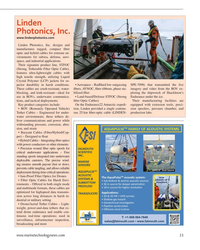 )
September 2025 - Marine Technology Reporter page: 33
)
September 2025 - Marine Technology Reporter page: 33in ROVs, underwater communica- • Land-based/Defense STFOC (Strong Endurance under the ice. tions, and tactical deployments. ? ber Optic Cables) Their manufacturing facilities are Key product categories include: On the Endurance22 Antarctic expedi- equipped with extrusion tools, preci- • ROV (Remotely Operated
-
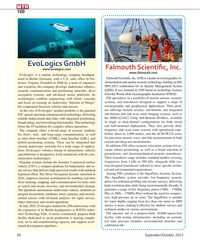 )
September 2025 - Marine Technology Reporter page: 30
)
September 2025 - Marine Technology Reporter page: 30an acoustic facility dedicated to serial production is nearing comple- test tank, pressure chamber, environmental chamber, and tion, set to add manufacturing capacity and support accel- calibration lab. erated development pipelines. 30 September/October 2025 MTR #7 (18-33).indd 30 MTR #7 (18-33)
-
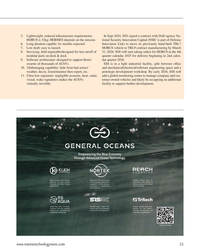 )
September 2025 - Marine Technology Reporter page: 25
)
September 2025 - Marine Technology Reporter page: 25capable: 6+ months expected Innovation Unit) to move its previously hand-built TRL7 7. Low draft: easy to launch HORUS vehicle to TRL9 contract manufacturing by March 8. Servicing: ? eld repairable/designed for fast on/off of 31, 2026. SSS will start taking orders for HORUS in the 4th modular parts
-
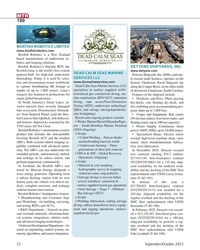 )
September 2025 - Marine Technology Reporter page: 22
)
September 2025 - Marine Technology Reporter page: 22(N3220525C4113) was awarded for a Rig Salvage (2023) Box? sh Robotics’ headquarters feature: 103-day shipyard availability for the o Scope: • Manufacturing and Customer Sup- regular overhaul and dry docking of the o Welding, fabrication, cutting, salvage port Workshop – for building, servicing,
-
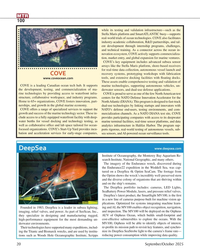 )
September 2025 - Marine Technology Reporter page: 20
)
September 2025 - Marine Technology Reporter page: 20, relief valves, and power. As part of SeeScan, Inc., and inspection. The MV100 will be deployed on the Orpheus they specialize in designing and manufacturing rugged, AUV of Orpheus Ocean, which builds small-footprint and high-performance equipment for the most demanding un- cost-effective submersibles
-
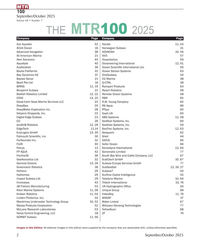 )
September 2025 - Marine Technology Reporter page: 2
)
September 2025 - Marine Technology Reporter page: 229 Sur? ine Costal Intelligence 55 Impact Subsea Ltd. 29 Teledyne Marine 10, 64 Innovasea 43 Tritech International 10, 76 JW Fishers Manufacturing 53 UK Hydrographic Of? ce 34 Klein Marine Systems 11, 28 Unique Group 68 Kraken Robotics 11, 54 VideoRay 11, 76 Linden Photonics
-
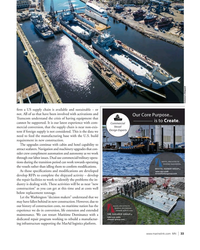 )
September 2025 - Marine News page: 33
)
September 2025 - Marine News page: 33with com- mercial conversion, that the supply chain is near non-exis- tent if foreign supply is not considered. This is the data we need to feed the manufacturing base with the U.S. build requirement in new construction. The upgrades continue with cabin and hotel capability to attract seafarers. Navigation
